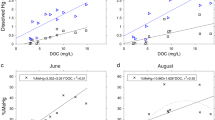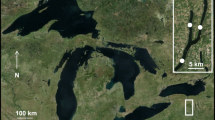Abstract
A number of recent studies have documented elevated concentrations of mercury (Hg) in fish caught in remote lakes and a pattern of increased concentrations of Hg in fish tissue with decreasing water column pH. Because of the potential linkage between fish Hg and surface water acidification, factors regulating water column concentrations and bioavailability of Hg were investigated in Adirondack lakes through a field study and application of the Mercury Cycling Model (MCM). Concentrations of total Hg and total MeHg were highly variable, with concentrations of total MeHg about 10% of total Hg in lakes which did not show anoxic conditions. In lakes exhibiting anoxic conditions in the hypolimnion during summer stratification, concentrations of total MeHg were elevated. Concentrations of total Hg and total MeHg increased with decreasing pH in remote Adirondack lakes. However, more importantly, concentrations of total Hg and total MeHg increased with increasing concentrations of dissolved organic carbon (DOC) and percent near-shore wetlands in the drainage basin. Mercury concentrations in muscle tissue of yellow perch from Adirondack lakes were elevated above the U.S. FDA action level (1 pg/g Hg) in 1% of the fish sampled or in one or more individual fish from 9 of the 16 lakes sampled. Fish Hg concentrations generally increased with increasing fish length, weight and age. Patterns of increasing Hg concentration with age likely reflect shifts in prey of yellow perch and the bioconcentration of Hg along the food chain. For age 3 to 5 perch, concentrations of Hg increased with increasing concentrations of DOC and percent near-shore wetlands in the drainage basin. However, for a lake with very high DOC concentrations, fish concentrations of Hg declined. Calculations with the MCM also show that concentrations of Hg species increase with increasing DOC due to complexation reactions. Increases in DOC result in increasing concentrations of Hg in biota but decreases in the bioconcentration factor of Hg in fish tissue. This research suggests that DOC is important in the transport of Hg to lake systems. High concentrations of DOC may complex MeHg, diminishing its bioavailability. At high concentrations of monomelic Al, the complexation of MeHg with DOC apparently decreases, enhancing the bioavailability of MeHg.
Access this chapter
Tax calculation will be finalised at checkout
Purchases are for personal use only
Preview
Unable to display preview. Download preview PDF.
Similar content being viewed by others
References
Bloom, N.: 1989, Can. J. Fish. Aquat. Sci. 46, 1131–1140.
Bodaly, R. A., Rudd, J. W. M., and Fudge, R. J. P.: 1993, Can. J. Fish. Aquat. Sci. 50, 980–987.
Cirmo, C. P. and Driscoll, C. T.: 1993, Wetlands. 13, 277–292.
Cope, W. G., Weiner, J. G., and Rada, R. G.: 1990, Environ. Toxicol. Chem. 9, 931–940.
Driscoll, C. T.: 1989, Die chemistry of aluminum in surface waters’, in Sposito, G. (ed.), The Environmental Chemistry of Aluminum, CRC Press, Boca Raton, FL., p. 241–278.
Driscoll, C. T. and van Dreason, R.: 1993, Water Air Soil Pollut. 67, 319.
Driscoll, C. T., Yan, C., Schofield, C. L., Munson, R., and Holsapple, J.: 1994, Environ. Sci. Technol. 28, 136–143.
Gill, G.A. and Bruland, K. W.: 1990, Environ. Sci. Technol. 24, 1392.
Gilmour, C. C., Henry, E. A., and Mitchell, R.: 1992, Environ. Sci. Technol. 26, 2281.
Grieb, T. M., Driscoll, C. T., Gloss, S. P., Schofield, C. L., Bowie, G. L., and Porcella, D. B.: 1990, Environ. Toxicol. Contam. 9, 919.
Haines, T. A., Komov, V., and Jagoe, C. H.: 1992, Environ. Pollut. 78, 1.
Hakanson, L.: 1980, Env. Poll. Ser. B. 1, 285–304.
Harris, R. C. and Snodgrass, W. J.: 1993, Water Pollut. Res. J. of Canada. 28, 217–236.
Hudson, R. J. M., Gherini, S. A., Watras, C. J., and Porcella, D. B.: 1994, ’A mechanistic model of the biogeochemical cycle of mercury in lakes’, in Watras, C. J. and Huckabee, J. W. (eds.) Mercury as a Global Pollutant, Lewis Publishers, Chelsea, MI (in press).
Keating, M.: 1994, Update on mercury studies by U.S. EPA, presented at Symp. on Mercury Contamination in the Northeast, 25 May, Cambridge, MA.
Lindqvist, O., Johansson, K., Astrup, M., Andersson, A., Bringmark, L., Hovsenius, G., Iverfeldt, A., Mieli, M., and Timm, B.: 1991, Water Air Soil Pollut. 55, i.
McMurty, M. J., Wales, D. L., Scheider, W. A., Beggs, G. L., and Dimond, P. E.: 1989, Can. J. Fish. Aquat. Sci. 46, 426.
Mierle, G. and Ingram, R.: 1991, Water Air Soil Pollut. 56, 349.
Rada, R. G., Powell, D. E., and Weiner, J. G.: 1993, Can. J. Fish. Aquat. Sci 50, 865–873.
Simonin, H. A., Gloss, S.P., Driscoll, C. T., Schofield, C. L., Kretser, W. A., Karcher, R.W., and Symula, J.: 1994. ’Mercury concentrations in yellow perch from Adirondack drainage lakes (New York, USA)’, in Trace Substances in the Environment, Lewis Publishers, Chelsea, MI, in press.
Sorensen, J. A., Glass, G. E., Schmidt, K. W., Huber, J. K., and Rapp, Jr., G. R.: 1990, Environ. Sci. Technol. 24, 1716–1727.
Suns, K., and Hitchin, G.: 1990, Water Air Soil Pollut. 50, 255–265.
Tarby, M. J.: 1974, Trans. Amer. Fish. Soc. 103, 462.
Verta, M.: 1990, Mercury in Finnish forest lakes and reservoirs: anthrogenic contribution to the load and accumulation in fish, Water Research Institute, National Board of Waters, Finland, No. 6.
Weiner, J. G., Fitzgerald, W. F., Watras, C. J. and Rada R. G.: 1990, Environ. Toxicol. Chem. 9, 909–918.
Winfrey, M. R., and Rudd, J. W. M.: 1990, Environ. Toxicol. Chem. 9, 853.
Wren, C. D. and MacCrimmon, H. R.: 1983, Can. J. Fish. Aquat. Sci. 40, 1737–1744.
Author information
Authors and Affiliations
Editor information
Editors and Affiliations
Rights and permissions
Copyright information
© 1995 Springer Science+Business Media Dordrecht
About this chapter
Cite this chapter
Driscoll, C.T., Blette, V., Yan, C., Schofield, C.L., Munson, R., Holsapple, J. (1995). The Role of Dissolved Organic Carbon in the Chemistry and Bioavailability of Mercury in Remote Adirondack Lakes. In: Porcella, D.B., Huckabee, J.W., Wheatley, B. (eds) Mercury as a Global Pollutant. Springer, Dordrecht. https://doi.org/10.1007/978-94-011-0153-0_54
Download citation
DOI: https://doi.org/10.1007/978-94-011-0153-0_54
Publisher Name: Springer, Dordrecht
Print ISBN: 978-94-010-4069-3
Online ISBN: 978-94-011-0153-0
eBook Packages: Springer Book Archive




